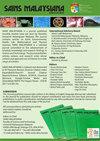Bioelectricity Generation from Bamboo Leaves Waste in a Double Chambered Microbial Fuel Cell
IF 0.8
4区 综合性期刊
Q3 MULTIDISCIPLINARY SCIENCES
引用次数: 0
Abstract
This study investigated the utilization of bamboo leaf waste and two varieties of bacterial sources, chicken manure and effective microorganism, in a microbial fuel cell (MFC) at three substrate concentrations (40 g/liter, 80 g/liter, and 160 g/liter). The primary objective was to investigate the kinetics of bacterial growth at various substrate concentrations in the MFC, as well as the effect of light conditions and pH on MFC power generation. The MFC had dual chambers with graphite electrodes serving as the cathode and anode. Within 72 h, the highest power density of 90.05 mV was attained using the highest substrate concentration of bamboo leaf waste and chicken manure during the logarithmic growth phase, albeit with a shorter duration. The longest sustained phase of bacterial activity was observed during the stationary phase, at the highest substrate concentration of 160 g/liter, followed by 80 g/liter and 40 g/liter. These results indicate that the logarithmic phase is the optimal time for bacterial activity in the MFC. However, attaining long-term stability in power generation in the logarithmic phase requires careful parameter optimization.利用竹叶废弃物在双腔微生物燃料电池中产生生物电
本研究调查了在三种底物浓度(40克/升、80克/升和160克/升)下,竹叶废弃物和两种细菌来源(鸡粪和有效微生物)在微生物燃料电池(MFC)中的利用情况。主要目的是研究MFC中不同底物浓度下细菌生长的动力学,以及光照条件和pH对MFC发电的影响。MFC具有双室,石墨电极用作阴极和阳极。在72小时内,尽管持续时间较短,但在对数生长阶段,使用最高基质浓度的竹叶废弃物和鸡粪,可获得90.05mV的最高功率密度。在固定阶段观察到细菌活性持续时间最长的阶段,最高底物浓度为160克/升,其次是80克/升和40克/升。这些结果表明对数阶段是MFC中细菌活性的最佳时间。然而,在对数阶段实现发电的长期稳定性需要仔细的参数优化。
本文章由计算机程序翻译,如有差异,请以英文原文为准。
求助全文
约1分钟内获得全文
求助全文
来源期刊

Sains Malaysiana
MULTIDISCIPLINARY SCIENCES-
CiteScore
1.60
自引率
12.50%
发文量
196
审稿时长
3-6 weeks
期刊介绍:
Sains Malaysiana is a refereed journal committed to the advancement of scholarly knowledge and research findings of the several branches of science and technology. It contains articles on Earth Sciences, Health Sciences, Life Sciences, Mathematical Sciences and Physical Sciences. The journal publishes articles, reviews, and research notes whose content and approach are of interest to a wide range of scholars. Sains Malaysiana is published by the UKM Press an its autonomous Editorial Board are drawn from the Faculty of Science and Technology, Universiti Kebangsaan Malaysia. In addition, distinguished scholars from local and foreign universities are appointed to serve as advisory board members and referees.
 求助内容:
求助内容: 应助结果提醒方式:
应助结果提醒方式:


